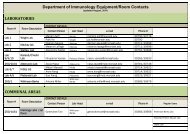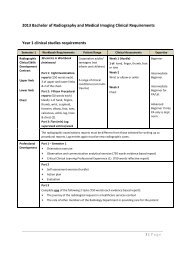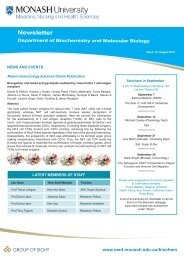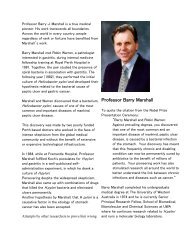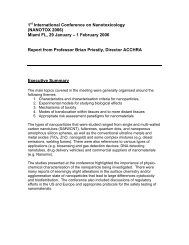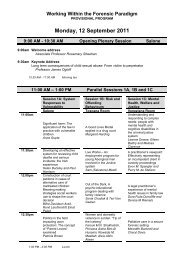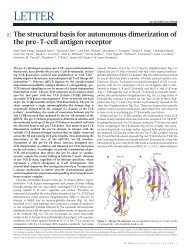Newsletter - Faculty of Medicine, Nursing and Health Sciences ...
Newsletter - Faculty of Medicine, Nursing and Health Sciences ...
Newsletter - Faculty of Medicine, Nursing and Health Sciences ...
Create successful ePaper yourself
Turn your PDF publications into a flip-book with our unique Google optimized e-Paper software.
SPOTLIGHT ON: Andrey Shubin<br />
Background<br />
After completing both a Bachelors <strong>and</strong><br />
Masters Degree in Chemical Technology<br />
<strong>and</strong> Biotechnology at Moscow<br />
State University <strong>of</strong> Fine Chemical<br />
Technology, I was enrolled in a PhD<br />
course in Biotechnology at the Institute<br />
<strong>of</strong> Molecular Genetics <strong>of</strong> Russian<br />
Academy <strong>of</strong> <strong>Sciences</strong> (IMG RAS). From<br />
the beginning <strong>of</strong> my research activity I<br />
have been working at the Laboratory <strong>of</strong><br />
Protein Engineering (IMG RAS) under<br />
the supervision <strong>of</strong> Dr. Ilya Demidyuk.<br />
The main objectives <strong>of</strong> investigation in<br />
our laboratory are proteolytic enzymes;<br />
with a core focus on their maturation<br />
<strong>and</strong> activation pathways, mechanisms <strong>of</strong><br />
substrate recognition <strong>and</strong> functioning, as<br />
well as possible applications <strong>of</strong> proteases<br />
in medicine <strong>and</strong> industry.<br />
My current PhD project considers<br />
proteases as potential therapeutic agents<br />
with the capability to induce death <strong>of</strong><br />
cancer cells. In the course <strong>of</strong> the project<br />
we have found that one <strong>of</strong> the tested<br />
enzymes - 3C protease <strong>of</strong> human hepatitis<br />
A virus - has a prominent cytotoxic effect,<br />
accompanied by massive cytoplasmic<br />
vacuolation. Since the vacuolation might<br />
result from the impairment <strong>of</strong> autophagy<br />
pathway <strong>and</strong> could reflect a natural<br />
role <strong>of</strong> the protease during infection, I<br />
was interested in uncovering a deeper<br />
characterisation <strong>of</strong> this effect. Luckily,<br />
due to the Australia Awards Fellowship<br />
Program, I have an excellent opportunity<br />
to carry this out at the Yeast Laboratory<br />
here at Monash University under the<br />
supervision <strong>of</strong> Pr<strong>of</strong>essor Rod Devenish.<br />
Projects<br />
All the research projects I participate<br />
in are related to different aspects <strong>of</strong><br />
proteolytic enzyme functioning. One<br />
<strong>of</strong> the investigations considers the<br />
information value <strong>of</strong> expression pr<strong>of</strong>iling<br />
<strong>of</strong> proprotein convertases (PC) <strong>and</strong><br />
matrix metalloprotease (MMP) genes in<br />
malignant tissues <strong>of</strong> human lungs. The<br />
key function <strong>of</strong> PC is processing <strong>and</strong>/<br />
<strong>Newsletter</strong>: April 2011, Issue 22<br />
or activation <strong>of</strong> numerous proteins <strong>and</strong><br />
peptides, many <strong>of</strong> which are associated<br />
with malignant diseases. MMPs are<br />
substrates <strong>of</strong> PCs <strong>and</strong> key factors in<br />
tumor invasion <strong>and</strong> metastasis. Systems<br />
<strong>of</strong> PCs <strong>and</strong> MMPs respond to malignant<br />
transformation, which suggests their<br />
expression status can be utilised as a<br />
possible marker for cancer typing <strong>and</strong><br />
prognosis. The most interesting result <strong>of</strong><br />
the project obtained so far is evidence<br />
that expression <strong>of</strong> PCs <strong>and</strong> MMPs genes<br />
in human lung tumors changes in a limited<br />
number <strong>of</strong> scenarios. These scenarios<br />
are characterised by a sharp increase<br />
in the expression level <strong>of</strong> a single PC<br />
without significant changes in expression<br />
<strong>of</strong> other proteases. We believe this result<br />
reflects the different pathways <strong>of</strong> tumor<br />
development <strong>and</strong> hope to confirm this<br />
finding in other types <strong>of</strong> cancer.<br />
Our laboratory is also focused on the<br />
investigation <strong>of</strong> the roles <strong>of</strong> propeptides<br />
in protease functioning. Most proteases<br />
are synthesised as propeptide-containing<br />
Department <strong>of</strong> Biochemistry <strong>and</strong> Molecular Biology<br />
precursors. These structural elements<br />
can determine folding <strong>of</strong> the cognate<br />
protein, function as an inhibitor/activator<br />
peptides, mediate enzyme sorting,<br />
<strong>and</strong> the interaction <strong>of</strong> a protease with<br />
other molecules <strong>and</strong> supramolecular<br />
structures. Even minor changes in<br />
propeptide structure can crucially alter<br />
protein function in the living organism.<br />
Modulatory activity coupled with<br />
high variation allows one to consider<br />
propeptides as specific evolutionary<br />
modules that can transform biological<br />
properties <strong>of</strong> proteases without significant<br />
changes in the highly conserved catalytic<br />
domains. As the considered properties <strong>of</strong><br />
propeptides are not unique to proteases,<br />
propeptide-mediated evolution seems to<br />
be a universal biological mechanism.<br />
For our investigations, we use the<br />
thermolysin-like M4 protease family<br />
as an experimental model. We have<br />
revealed that according to structure <strong>of</strong><br />
their propeptides, M4 proteases are<br />
divided into two distinct groups, even<br />
though the mature enzymes have largely<br />
similar sequences. Proteases <strong>of</strong> the first<br />
group have relatively long propeptides,<br />
are known to act as intramolecular<br />
chaperones <strong>and</strong> inhibitors <strong>of</strong> cognate<br />
mature proteins. Proteins <strong>of</strong> the second<br />
group have short propeptides <strong>and</strong><br />
resemble protealysin from Serratia<br />
proteamaculans. We have obtained a<br />
crystal structure <strong>of</strong> protealysin (which<br />
was the first example <strong>of</strong> thermolysin-like<br />
peptidase precursor crystal structure)<br />
<strong>and</strong> revealed an inhibitor function <strong>of</strong> its<br />
short propeptide. However, the existence<br />
<strong>of</strong> two different groups <strong>of</strong> propeptides<br />
makes one think that short propeptides<br />
have other specific functions which are<br />
still to be clarified.<br />
In spite <strong>of</strong> our focus in the fields mentioned<br />
above, we are always interested in<br />
collaborations <strong>and</strong> new projects related to<br />
different aspects <strong>of</strong> protease functioning<br />
<strong>and</strong> keen to broaden our research<br />
horizons.<br />
Page 8





